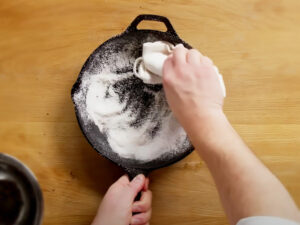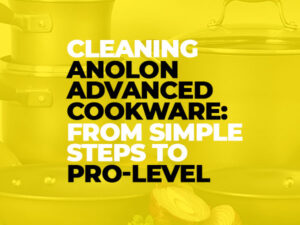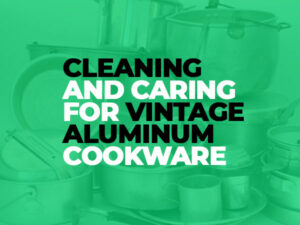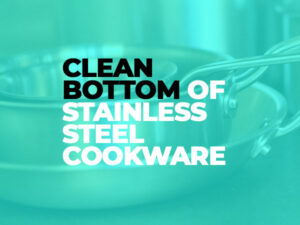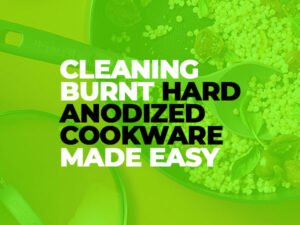Cooking with Calphalon nonstick cookware is a joy for many home chefs. Their superior non-stick coating allows food release and effortless cleaning, but to maintain their performance and longevity it’s essential to follow proper cleaning practices. In this comprehensive guide, we’ll cover everything you need to know about keeping your Calphalon pans spotless and long-lasting through proper tool collection, stain removal techniques, and common mistakes. Gather all necessary tools and materials before beginning this comprehensive cleaning journey so you’re prepared!
Understanding the Importance of Proper Cleaning Calphalon Nonstick Cookware
Calphalon nonstick cookware is designed with a durable nonstick coating that offers excellent food release and easy cleaning. However, improper cleaning practices can damage this coating, decreasing its effectiveness over time. Therefore, it’s essential to understand how important proper maintenance is in order for your Calphalon cookware to maintain its performance and last for years to come.
Equipping Yourself with the Appropriate Tools and Materials for Effective Cleaning:
Before beginning the cleaning process, it’s essential to gather all the necessary tools and materials. These include a soft sponge or cloth, non-abrasive scrub brush, mild dish soap, baking soda, white vinegar, and soft towel or paper towel for drying. Avoid using abrasives such as steel wool or harsh cleaners that could scratch or damage the nonstick coating.
Cleaning Your Calphalon Nonstick Cookware:
Once you have all your tools and materials together, it’s time to prepare your Calphalon cookware for cleaning. Start by allowing the pans to cool completely before beginning; hot pans can cause burns and make cleaning difficult. Next, scrape away any food debris or residue with a soft sponge or cloth; avoid using metal utensils or abrasive tools that could scratch or dent the nonstick coating.
How-To Guide for Cleaning Calphalon Cookware’s Interior Nonstick Coating
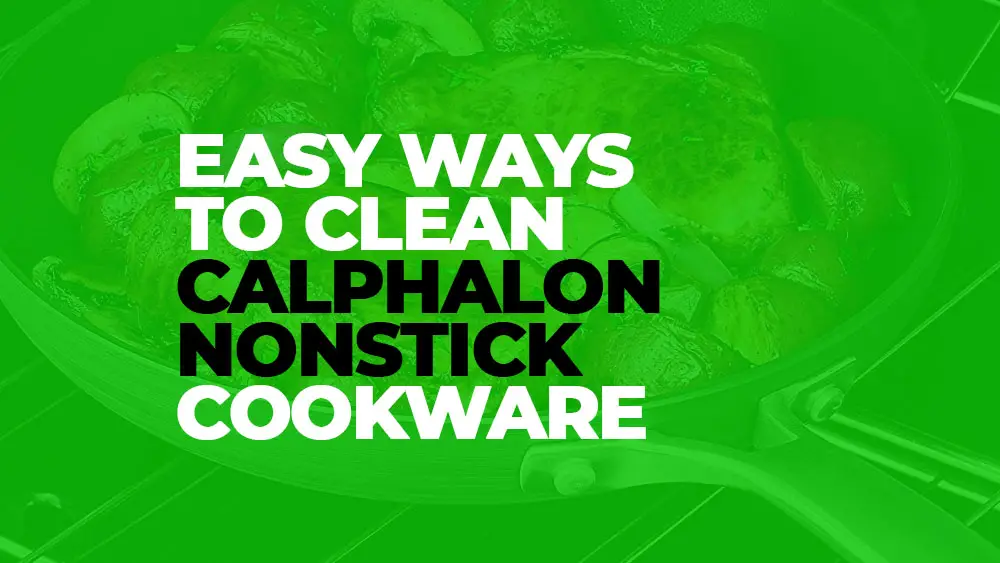
Calphalon cookware’s nonstick interior requires gentle cleaning to prevent damage. Here are our step-by-step instructions for effective cleanup:
Step 1: Fill the Sink or Basin with Warm Soapy Water – To get your nonstick coating looking its best, fill your sink or basin with warm water and add a few drops of mild dish soap. Avoid using harsh detergents or abrasives that could damage it.
Step 2: Soak the Cookware – Place your Calphalon cookware in warm, soapy water and soak for 10-15 minutes. Doing this will loosen any stuck-on food residue and make cleaning much simpler.
Step 3: Scrub With a Soft Sponge or Cloth – After soaking, use a gentle sponge or cloth to scrub the interior of the cookware. Avoid using abrasives that could scratch its nonstick coating. Pay special attention to areas with food residue or stains for extra attention.
Step 4: Rinse Thoroughly – Once the interior of the cookware is clean, thoroughly rinse it with warm water to eliminate all soap residue.
Step 5: Dry Completely – To ensure the cookware is dry, use a soft towel or paper towel to completely dry it before storing it. Avoid air-drying as moisture can promote mold or mildew growth.
Combatting Stubborn Stains: Tips and Techniques for Eliminating Sticky Residue
Calphalon nonstick cookware may still contain stubborn stains and residue even with regular cleaning. Here are some tips and techniques to help you effectively tackle tough stains:
Baking Soda Paste: Make a paste by mixing equal parts baking soda and water. Apply the mixture to stained areas and let sit for 10-15 minutes, then gently scrub with a non-abrasive brush or sponge. Rinse thoroughly and pat dry.
White Vinegar Solution: Create a spray bottle with equal parts white vinegar and water, then spray onto the stained area. Let sit for several minutes, then gently scrub with a soft sponge or cloth. Rinse thoroughly and pat dry to complete removal.
Lemon Juice: Slice a lemon in half and rub it directly on the stained area. The natural acidity of lemon juice can help break down tough stains. Rinse thoroughly with water before drying.
Boiling Water: If you have stubborn stains on the bottom of your Calphalon cookware, boiling water may help loosen them. Fill the cookware with water and bring it to a boil, let simmer for several minutes, then carefully pour out of the heat. Scrubbing away residue with a soft sponge or cloth is recommended; make sure all surfaces are rinsed thoroughly afterward and pat dry.
Caring for Calphalon Nonstick Cookware’s Exterior: Cleaning It Outside
Calphalon cookware’s interior nonstick coating is essential, but it also needs regular care on the outside to preserve its aesthetic and performance. Here are some tips for cleaning Calphalon cookware’s exterior:
Hand Washing Calphalon Cookware Exterior: Always hand wash the exterior of your Calphalon cookware with warm, soapy water and a soft sponge or cloth. Avoid using abrasives or harsh cleaners that could scratch or dull the surface.
Dry Thoroughly: After washing the exterior of the cookware, be sure to completely dry it with a soft towel or paper towel. Moisture can lead to discoloration or surface damage if not dried properly.
Storing Correctly: Keep your Calphalon cookware dry and well-ventilated to prevent moisture buildup. Avoid stacking pans as this may lead to scratches or chips.
Avoiding Common Cleaning Mistakes with Calphalon Non-Stick Cookware: Dos and Don’ts
To maintain your Calphalon nonstick cookware in top condition, it’s essential to avoid common cleaning errors. Here are some dos and don’ts when it comes to cleaning your Calphalon cookware:
Dos:
- Use a soft sponge or cloth for cleaning.
- Make use of mild dish soap and warm water when necessary.
- Dry your cookware thoroughly before storing it.
- Do utilize gentle cleaning techniques, such as baking soda paste or white vinegar solution, for tough stains.
Don’ts
- Don’t use abrasives such as steel wool or abrasive cleaners that could scratch the nonstick coating.
- Avoid using metal utensils or sharp objects that could damage the nonstick coating.
- Air-dry your cookware to prevent moisture damage which could lead to mold or mildew growth.
- Avoid stacking cookware together as this could cause scratches or chips.
Deep Cleaning Techniques for Calphalon Nonstick Cookware:
In addition to regular cleaning, deep-cleaning should be performed periodically in order to eliminate any buildup or residue that could negatively affect the performance of your Calphalon nonstick cookware. Here are some effective deep cleaning techniques:
Vinegar and Water Solution: Combine equal parts white vinegar and water in a pot or pan and bring it to a boil. Allow it to simmer for 10-15 minutes, then strain out the solution and rinse thoroughly with water. This can help remove tough stains and residue from cookware.
Baking Soda and Water Paste: For stubborn stains, create a paste by mixing equal parts baking soda and water. Apply it both inside and outside your cookware, leaving it sit for at least 30 minutes (or overnight) before gently scrubbing with a soft brush or cloth. Rinse thoroughly and dry completely.
Salt and Lemon Juice Scrub: Combine equal parts of salt and lemon juice to form a paste. Apply this to stained areas and scrub gently with either a soft brush or cloth, using the salt as an abrasive while the lemon juice helps break down stains. Rinse thoroughly and pat dry.
Boiling Water and Dish Soap Soak: Fill your cookware with water, then add a few drops of mild dish soap. Bring this to a boil and simmer for 10-15 minutes. Then pour out the soapy water and scrub gently with either a soft brush or cloth. Rinse thoroughly and dry completely.
Oven Cleaning Method: If the exterior of your Calphalon cookware has stubborn stains that are difficult to remove, try the oven cleaning method. Preheat your oven to 450degF (230degC). Mix equal parts water and baking soda into a paste then apply it directly on stained areas before placing the cookware in the oven for 15 minutes. Carefully take it out of the oven and scrub gently with a soft brush or cloth; rinse thoroughly and air-dry.
Barkeeper’s Friend Cleanser: Barkeeper’s Friend is an effective abrasive cleanser that can be used to gently and thoroughly remove tough stains and residue from Calphalon nonstick cookware. Use it according to the package instructions, but be careful as too much use may cause scratches. Rinse thoroughly then pat dry.
Taking Care of Calphalon Non-Stick Cookware’s Handles and Lids:
Your Calphalon nonstick cookware’s handles and lids require regular care to prolong their longevity. Here are some tips for cleaning and maintaining these components:
- Hand Washing: Always hand wash the handles and lids of your product using warm, soapy water and a soft sponge or cloth. Avoid leaving them submerged for extended periods as this can damage them.
- Dry Thoroughly: After washing, thoroughly dry the handles and lids with a soft towel or paper towel to prevent moisture buildup.
- Avoiding Extreme Heat: Be mindful when exposing handles and lids to intense heat sources such as an open flame or broiler, since this can lead to discoloration, warping, or melting of the metal components.
- Check for Loose Screws: Regularly check the screws on handles and lids to make sure they are tight. Loose screws can cause handles or lids to become wobbly or fall off, compromising their functionality.
- Avoid Harsh Cleaners: Be gentle when using harsh cleaners or abrasives on handles and lids to avoid scratches or damage to their finish.
Maintaining Calphalon Cookware’s Nonstick Coating:
Calphalon cookware’s nonstick coating is the most essential feature, allowing food release and preventing sticking. Maintaining this layer is key for optimal performance and longevity; here are some tips:
Use Plastic or Wooden Utensils: Always use plastic, silicone, or wooden utensils when cooking with Calphalon nonstick cookware. Metal utensils can scratch and damage the nonstick coating, decreasing its effectiveness.
Avoid High Heat: Calphalon nonstick cookware is designed for optimal performance at low to medium heat settings. Avoid using high temperatures as this may cause the nonstick coating to deteriorate or peel off.
Seasoning: Seasoning the nonstick coating on cookware can improve its performance and extend its lifespan. To season, heat over low heat and apply a thin layer of vegetable oil or cooking spray. Spread it evenly across the surface using a paper towel or cloth, let it cool, then wipe away any excess oil or spray. Seasoning should be done periodically to maintain the nonstick layer.
Hand Washing Calphalon Nonstick Cookware: Always hand wash Calphalon nonstick cookware with warm, soapy water and a soft sponge or cloth. Avoid using abrasives or harsh cleaners that could damage the nonstick coating.
Avoid Stacking: To protect the nonstick coating of Calphalon cookware from scratches or damage, avoid stacking them atop each other without adequate protection. Place a paper towel or soft cloth between each cookware piece to minimize scratching.
Storage: Keep Calphalon cookware dry and cool to prevent moisture buildup which could erode the nonstick coating over time. Avoid stacking heavy items on top of them as this could cause warping or damage.
Regular Inspection: Regularly check the nonstick coating on Calphalon cookware for any signs of wear, such as peeling, flaking or scratches. If you observe any damage, discontinue use and consider replacing the cookware.
Follow Manufacturer’s Instructions: Always refer to the Calphalon cookware manufacturer’s instructions for care and maintenance when using it. Different types of Calphalon cookware may have specific care needs, so be sure to read and follow these directions to guarantee proper care.
Conclusion
Proper care and maintenance of your Calphalon cookware are key for keeping it looking its best and extending its lifespan. By following the tips mentioned above, you can keep your nonstick Calphalon cookware looking and performing its best for years to come. Always hand wash, avoid using abrasives, season the nonstick coating, and follow the manufacturer’s instructions for care and maintenance – these steps will guarantee reliable performance with delicious meals for years to come – happy cooking!


